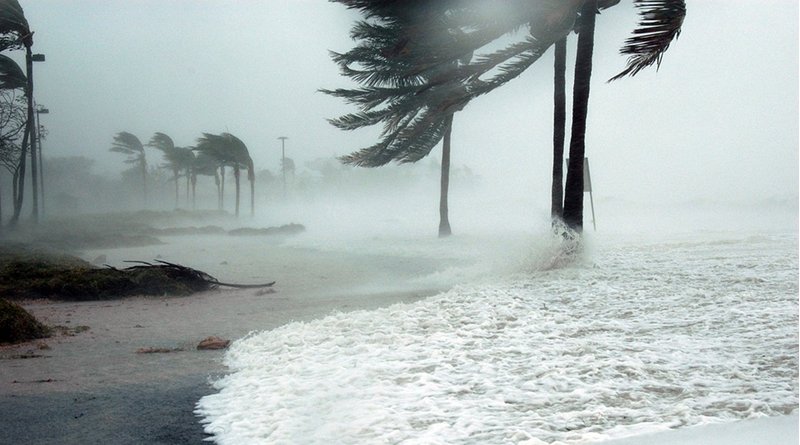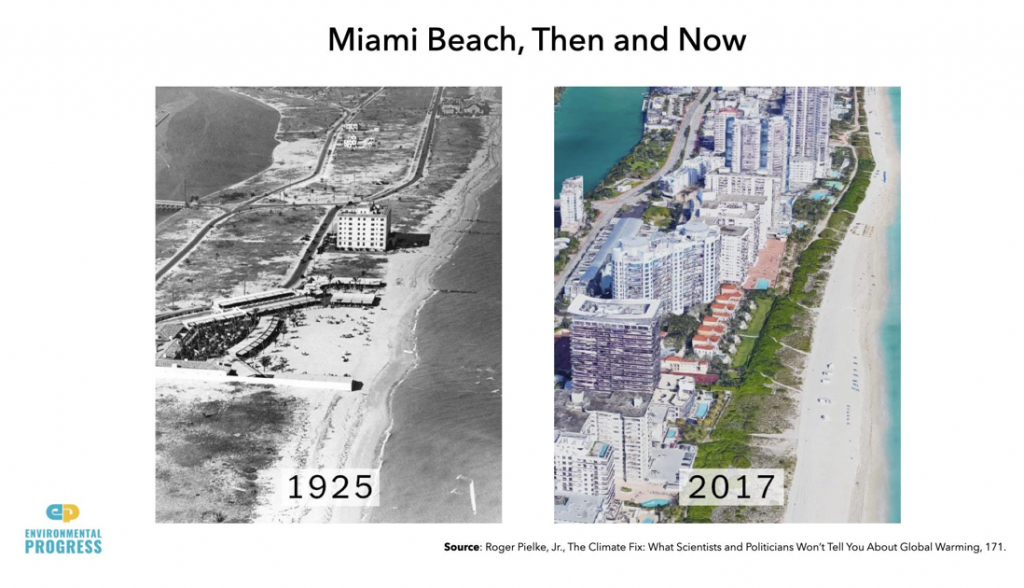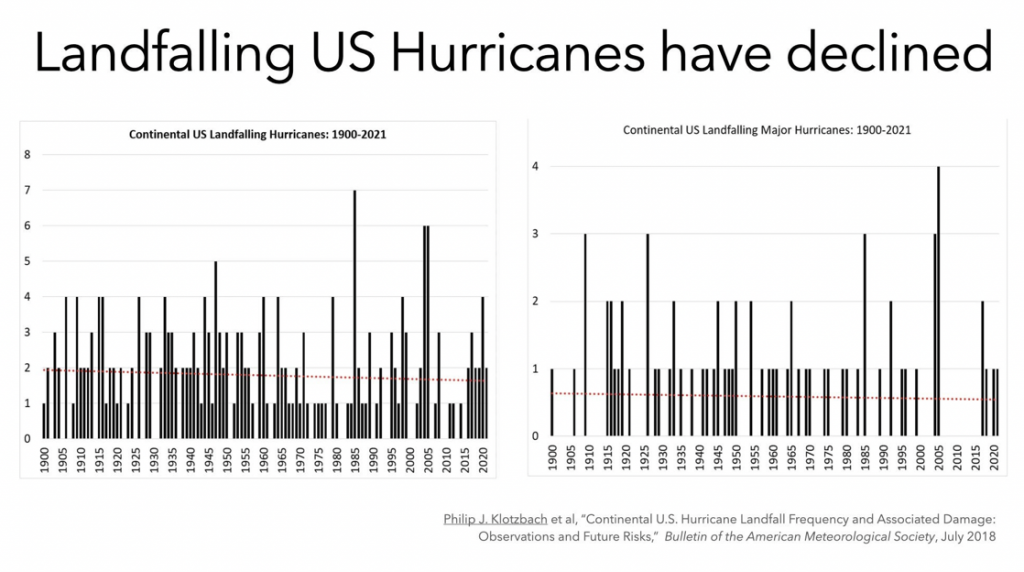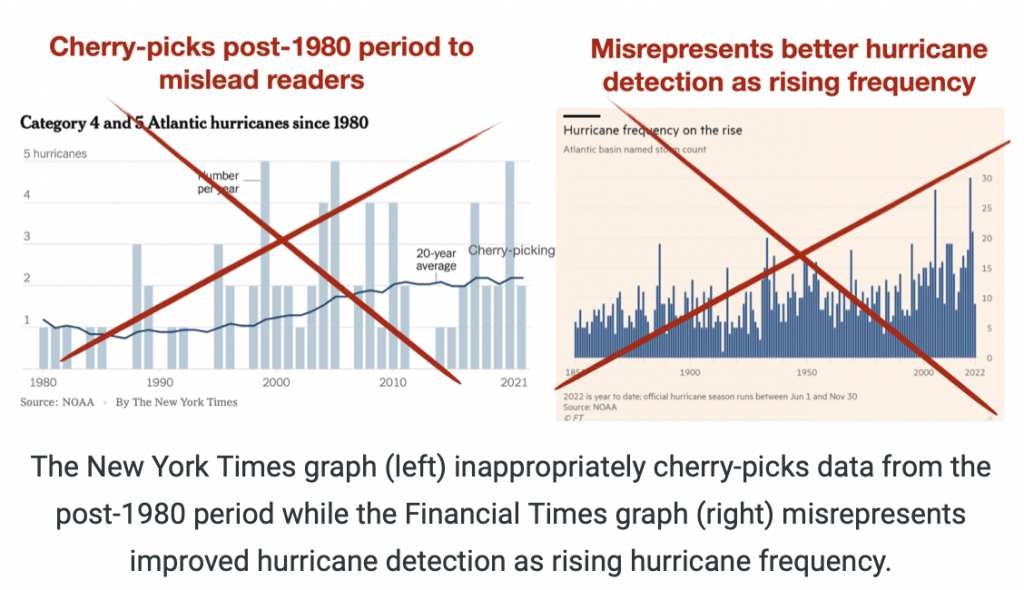Media Lying About Climate And Hurricanes – OpEd

Over the last several weeks, many mainstream news media outlets have claimed that hurricanes are becoming more expensive, more frequent, and more intense because of climate change.
- The Financial Times reported that “hurricane frequency is on the rise.”
- The New York Times claimed, “strong storms are becoming more common in the Atlantic Ocean.”
- The Washington Post said, “climate change is rapidly fueling super hurricanes.”
- ABC News declared, “Here’s how climate change intensifies hurricanes.”
- Both the FT and N.Y. Times showed graphs purporting to show rising hurricane frequency using data from the U.S. government’s National Oceanic and Atmospheric Administration (NOAA).
All of those claims are false.
The increasing cost of hurricane damage can be explained entirely by more people and more property in harm’s way. Consider how much more developed Miami Beach is today compared to a century ago. Once you adjust for rising wealth, there is no trend of increasing damage.

Claims that hurricanes are becoming more frequent are similarly wrong. “After adjusting for a likely under-count of hurricanes in the pre-satellite era,” writes NOAA, “there is essentially no long-term trend in hurricane counts. The evidence for an upward trend is even weaker if we look at U.S. landfalling hurricanes, which even show a slight negative trend beginning from 1900 or from the late 1800s.” What’s more, NOAA expects a 25% decline in hurricane frequency in the future.
What about intensity? Same story. Explains NOAA, “after adjusting for changes in observing capabilities (limited ship observations) in the pre-satellite era, there is no significant long-term trend (since the 1880s) in the proportion of hurricanes that become major hurricanes.“ Bottom line? “We conclude that the data do not provide compelling evidence for a substantial greenhouse warming-induced century-scale increase in: frequency of tropical storms, hurricanes, or major hurricanes, or in the proportion of hurricanes that become major.”

NOAA indeed predicts a 5% increase in hurricane intensity by 2100, but no increase in intensity is today detectable. And the best-available science forecasts that the slight increase in overall hurricane intensity in the future won’t be because there are more intense hurricanes but rather because hurricanes overall will decline more than intense hurricanes (category 4 and 5). As a result, there will be a greater proportion of category 4 and 5 hurricanes than categories 1, 2, and 3.
In other words, the relative intensity of hurricanes will rise, even as the total number of hurricanes — and the total number of intense hurricanes — decline.
Why are the media spreading obviously inaccurate information, and not reporting the basic facts? Are journalists simply ignorant? Or is something else going on?
Evidence Of Deliberate Deception

Is it possible journalists are just ignorant of current climate science? Perhaps some are. But mainstream news media outlets have been covering climate change and hurricanes for the last 20 years. And the information on hurricane costs, frequency, or intensity is hardly hidden away. It’s been summarized in the IPCC reports, most recently in 2021. And NOAA even boldfaces its key conclusions.
Consider four of the main ways the media mislead the public about climate change and hurricanes. They:
- Misrepresent data showing improved observations of hurricanes (thanks in large measure to satellites and other hurricane detection technologies) as evidence of more frequent hurricanes;
- Misrepresent hypotheses (e.g., that some hurricanes may become more intense by 2100) as facts in the present without mentioning that median projections suggest a decrease in all categories of storms;
- Cherry-pick data to present trends in a relatively recent period since the 1980s and ignore the fact that there is much longer-term data available;
- Confuse increasing damage with increasing incidence or intensity, even as there is a strong understanding that what and where we build explains all escalating disaster damage.
Is it possible that the Financial Times reporter Aime Williams and her editors pulled the data from the NOAA website to make their graph, and mistakenly claimed that it shows more frequent hurricanes, but didn’t happen to read the website and its explicit warning that “After adjusting for a likely under-count of hurricanes in the pre-satellite era, there is essentially no long-term trend in hurricane counts”?
If that is indeed what occurred, then Williams and FT are guilty of journalistic malpractice of the highest order. But there is little reason to think that’s what happened. NOAA makes its warning relatively early on its web page and repeats it several times. And FT, like everyone else, has been covering this issue for decades not years.
I asked Williams in an email why she reported that hurricanes were increasing in frequency and intensity, against the best available science, and she did not respond. Whatever the case, FT should issue a retraction or a correction.
Washington Post reporters Scott Dance and Kasha Patel claim that “storms rated Category 4 or stronger… have increased in number in recent decades” and their headline reads, "climate change is rapidly fueling super hurricanes.”
Those claims are, respectively, misleading and wrong. According to NOAA, 15 Category 4 or stronger hurricanes made landfall in Florida since 1919, with 10 of them occurring before 1960 (over 42 years) and 5 of them since (over 62 years).
There is evidence that Dance and Patel knew they were being misleading. Consider the following sentence from their article: “One comparable period of hurricane activity came from 1945 to 1950, when five Category 4 hurricanes hit Florida in six years, making [hurricane researcher Philip] Klotzbach reluctant to call the series of intense storms since 2017 unprecedented.”
The word “reluctant” softens the meaning. “Refuses” would be a more accurate word. And he refuses to call the storms unprecedented because, as Dance and Patel acknowledge, they aren’t.
It’s worth pausing on this point for a moment. Klotzbach clearly explained the data to Dance and Patel. They clearly understood it. And yet they softened and buried Kotzbach’s debunking of their headline claim as though it were a quibble.
I emailed Dance and Patel and asked about their reporting decisions, and a Washington Post spokesperson responded with an email that said, “We stand by our reporting on the unusually high number of major hurricanes to make landfall along the U.S. in recent years and which experience rapid intensification, sometimes shortly before landfall. Studies referenced in the article, including analysis by the United Nations Intergovernmental Panel on Climate Change, as well as work by NOAA have stated the increase in rapid intensification events over the past three to four decades likely cannot be explained by natural variability alone.”
But what she said doesn’t make sense, and contradicts the best-available science. Four decades ago, the 1980s, was a period of historic lows. And the scientific consensus is that natural variability does, in fact, explain the post-1980 increase. “After homogenization,” wrote a team of scientists last year, “increases in basin-wide hurricane and major hurricane activity since the 1970s are not part of a century-scale increase, but a recovery from a deep minimum in the 1960s–1980s. We suggest internal (e.g., Atlantic multidecadal) climate variability and aerosol-induced mid-to-late-20th century major hurricane frequency reductions have probably masked century-scale greenhouse-gas warming contributions to North Atlantic major hurricane frequency.” [emphasis added]
Whether it is a case of poor journalism or deliberate deception, The Washington Post should issue a retraction or correction.
What about the article in The New York Times, by-lined by David Leonhardt, which claims that "strong storms are becoming more common in the Atlantic Ocean”? What about its graph, which shows a trend of rising category 4 and 5 storms starting in 1980?
The 1970s and 1980s are well-understood to be the low point in hurricane activity in the 20th Century. In a paper titled “Changes in Atlantic major hurricane frequency since the late-19th century,” which Nature Communications published last year, scientists wrote, “the inactive period in the late 20th century may have been the most inactive period in recent centuries.” So, of course, a time series starting in 1980 will show increased activity.
It is an obviously deliberate and egregiously unprofessional choice.
I have known David for over a decade and know that he can be a careful reporter when he chooses to be. He did some of the most honest reporting for The New York Times on Covid. He won Pulitzers in 2010 and 2011. I emailed David to ask what made him decide to cherry-pick those dates; I have not heard back. Whatever the case, The New York Times should retract or correct the article.
It is notable that journalists twist themselves into pretzels to create the impression that hurricanes are increasing in frequency and intensity without ever acknowledging the data showing that they are not. A simple graph of U.S. landfalls shows that. And yet no major media outlet has ever, to my knowledge, published it.
Consider my on-line interaction with Ginger Zee, chief meteorologist and managing editor of the climate unit of ABC News. In a tweet I wrote, “I have not seen a single mainstream news media outlet mention any of this,” in reference to the NOAA forecast of declining frequency and increasing intensity of hurricanes.
Responded Zee, “We have! Global cyclone frequency down, studies show you need the difference in cold and warm as you go up, & all warming, so less cyclone starts(cyclone is general term for hurricane/typhoon), HOWEVER, once they do start, better chance of rapidly intensifying w/ warmer ocean water.”
I responded, “Ginger, how do you justify the ABC headline given NOAA’s explicit statement that “data at this stage do not provide compelling evidence for a substantial greenhouse warming-induced century-scale increase in… the proportion of hurricanes that become major hurricanes”?”
She responded, “That article is Referencing this Noaa study:https://gfdl.noaa.gov/global-warming-and-hurricanes/… , @KentonGewecke &@RobMarciano covered this weekend on GMA…We are also all aware of confidence in relationship to CC.”
I replied, “Thanks, Ginger, but that doesn’t answer my question. Do you think the ABC headline, which implies hurricanes *are* intensifying, is accurate, given NOAA’s insistence that such claims can’t be made?”
She didn’t respond. However, Zee made clear that she and her colleagues Kenton Gewecke and Rob Marciano were aware of the NOAA web page that warns that there is no evidence of increasing hurricane frequency or intensity.
How she responded after that seemed indicative of much of the media coverage, which is to pivot away from the cold hard facts and towards presenting speculation and hypothesis as certain. And indeed, when you read through media coverage of climate change, you often find reporters emphasizing that they can’t entirely attribute any given hurricane to climate change, only that “climate change makes such events more likely.”
But such statements are a dodge. The reason we can’t attribute trends in hurricanes to climate change is that since reliable records started being kept the data indicates that hurricanes aren’t increasing in either frequency or intensity — full stop. To suggest that “climate change makes stronger hurricanes more likely or frequent” inappropriately misleads listeners and readers to believe that hurricanes are growing more likely or frequent.
As such, it’s clear that reporters are deliberately seeking to convince their readers and listeners of the false impression that hurricanes are becoming more frequent and intense. Many reporters do so in a subtle way, like ABC’sZee, while others are more direct about it, like the FT’s Williams
Moreover, these “mistakes” are occurring within a larger context of excluding relevant information, including what I view as the three biggest findings about the relationship between climate change and disasters:
- deaths from natural disasters have declined dramatically over many decades;
- costs from natural disasters have also declined as a proportion of our exposure;
- the frequency of natural disasters is declining this century.
The Climate Alarmists’ War on Scientists
The final piece of evidence that journalists are aware of the fact that hurricanes are becoming neither more frequent nor more intense comes from the vicious war waged against the most important and most outspoken scientist in the field, Roger Pielke, Jr.
University of Colorado scientist Pielke, Jr. in the late 1990s literally invented the method of “normalizing” the cost of hurricanes to account for a rising population, buildings, and wealth as the factors capable of explaining all of the rising cost of hurricanes, which meant that he and his colleagues discovered that there was no evidence that climate change was so far detectable in the escalating costs of hurricane disasters.
Pielke, Jr. has for a quarter-century a strong advocate for strong action on climate change. But because his scientific work on hurricanes undermines climate alarmism, progressive activists and Democrats in Congress and the White House have vilified him. In 2008, the Center for American Progress, led by John Podesta, the former chief of staff to Bill Clinton and campaign chairman for Hillary Clinton’s 2016 presidential campaign, joined in on a shockingly vicious and personal series of attacks on Pielke, including falsely claiming he was funded by fossil fuel interests.
All of these efforts were plainly aimed at discrediting Pielke, Jr., to journalists. They triggered an enormous quantity of media coverage which culminated in a 2014 effort by CAP to get Pielke, Jr. fired as a columnist for Nate Silver’s website, fivethirtyeight.com, after it published an article by Pielke, Jr. summarizing the science showing no increase in hurricane frequency or intensity.
Pielke, Jr. then wrote about the experience of being canceled by fivethirtyeight.com in The Wall Street Journal in 2016. I wrote about the attacks in Apocalypse Never, in a viral article I wrote introducing the book, and again last week. Every senior editor, producer, or reporter working in a mainstream news media outlet knows about the debate over Pielke, Jr.’s work, and the fact base behind it.
Roger has responded to these attacks, which have undermined his professional career, and intimidated his colleagues, many of whom behaved with the cowardice typical of academics today, with grace and dignity. He is a model of courage in public life. You can support him by taking a moment now to subscribe to his excellent, must-read Substack.
I asked Roger whether he thought most reporters knew that hurricanes are not increasing in frequency and intensity, and were choosing to present information aimed at giving readers the opposite impression. He pointed to the graphs showing no change, and even a slight decline, in landfalling hurricanes and in major hurricanes.
“We should ask why the data in these graphs have never appeared in the mainstream media,” he said. “Journalists should understand that by playing things straight with their readers and the public, more trust is gained in their work and in climate science more generally. People are not fools and won’t be tricked for long. Good science always wins in the end, even if it takes a little while.”
It’s one thing for a journalist to accuse his fellow journalists of getting something wrong; it’s quite another to accuse them of deliberately misleading the public. The former is understandable and forgivable. We all make mistakes. But to deliberately mislead the public is a violation of the duty of the journalist to report basic facts accurately. To accuse a journalist of deliberately misleading the public is to accuse him or her of lying. I recognize that it’s a very serious charge.
But it is time to state the obvious. The media are consciously and deliberately misleading the public about the relationship between climate change and hurricanes. That means they are lying. Mainstream news reporters, and their editors, at The Financial Times, New York Times, Washington Post, ABC News, and other outlets know perfectly well that hurricanes are not increasing in either frequency or intensity and have decided to mislead readers and viewers into believing the opposite.
It’s time for that to change.